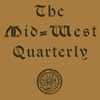
Mid-West Quarterly (1913–1918)
Date of this Version
1914
Document Type
Article
Abstract
" Never has he drawn so deeply from the well that is the human heart; never so near those invisible heights which are the soul." The reviewer who wrote this sentence probably meant that the author of the book he so enthusiastically welcomed wrote with a little more than the ordinary insight. Indeed if we are to judge from the encomiums in our less critical reviews the world has never been so blessed with novels and plays which touch the secret springs of the heart. The old fiction had generalised, had conventionalised, much as the old art had done. This, to the new, is all wrong. The type characters, let us say, of Thackeray and even of George Eliot were interesting enough, but often as faulty as the old drawings of a galloping horse, which showed him with feet extended in an arc. As the art of photography has taught us that the horse has always one of his feet on or near the ground, so the new psychology has put us on our guard against accepting too literally such personages as Becky Sharp, Colonel Newcome, or Silas Marner. These pictures of life are entirely too set, far too regular for an adequate portrayal of life itself. The new fiction is to present life itself, "to draw deeply from the well that is the human heart," to mount "near the invisible heights which are the soul." And thus vivisectionist-wise, the writers of to-day stand, with scalpel and forceps delicately poised, before a clinic of admiring readers.


Comments
Published in THE MID-WEST QUARTERLY 2:1 (October 1914), pp. 74-94. Published by G.P. Putnam’s Sons & the University of Nebraska.